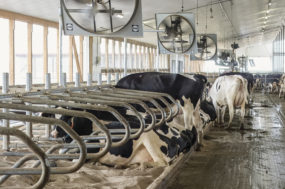The current issue of Progressive Dairyman contains recaps of several prominent dairy reform plans. The issue should be in mailboxes very soon. (My copy arrived in the mail today.) This morning we received the following comment/question from David Brand in Waterloo, Indiana, through Twitter regarding all of the dairy reform plans and our current poll question. BrandFarms:@PDmag No dairy reform plan allows for already existing internal herd growth. We have 200+ hfrs < a yr old from R own cows. What do we do?
From yesterday's Daily Dairy Report and USDA Milk Production report, it's pretty obvious what dairymen are doing under the current rules. Dairymen are culling more aggressively but not cutting back total herd numbers. The U.S. dairy herd was up 3,000 cows from March. Younger, fresher heifers are making up a greater portion of all dairy producers' herds, pushing average per-cow production to new highs. Total U.S. milk production is practically steady, up just 14,000 cows this year.
Last week I spoke with representatives from a prominent A.I. stud. I asked if they continue to hear grief about sexed semen and why they continue to sell it. They made an interesting comparison between sexed semen and rBST and said dairymen sometimes say the same line about the two, "Why did we ever start using this stuff?" Regardless, most producers say they won't give up using it. They are hooked.
How could they give it up? The new competitive standard for dairymen today is to have a young milking string that you can continually replace. If you don't use sexed semen, you will be buying younger replacements from someone who does or be milking a relatively older herd that isn't as competitive.
The youth of the U.S. dairy herd also builds in natural elasticity in milk production capability. If prices do climb at all, producers can scale back their aggressiveness in culling, continue to keep the heifer pipeline value wide open and fill up their barns again.
I've heard critics of supply management hold up the increasing number of youngstock as one of their key complaints of such plans. They say that if quotas, market access fees, or whatever else the supply restrictions may be called, aren't permitting growth, the value of those youngstock will decline domestically. These critics say they may even be sold overseas to competing dairy nations.
Current USDA estimates do not directly factor in cattle prices into monthly cost of production for milk. So unless plans change from their current form to specify that this be added to the equation, cost of production will not address this issue.
How to handle cattle supply and the future of the CWT are the biggest question marks of NMPF's Foundation for the Future plan. More details should be available when a final version of the plan is released at the end of June.
Thanks for the question. It's a good one. We'll ask each of the plans to respond when we question them about other outstanding issues in upcoming editions of Progressive Dairyman.
In the meantime, keep doing what you're doing. It's the only way to stay competitive. PD

-
Walt Cooley
- Editor
- Email Walt Cooley



